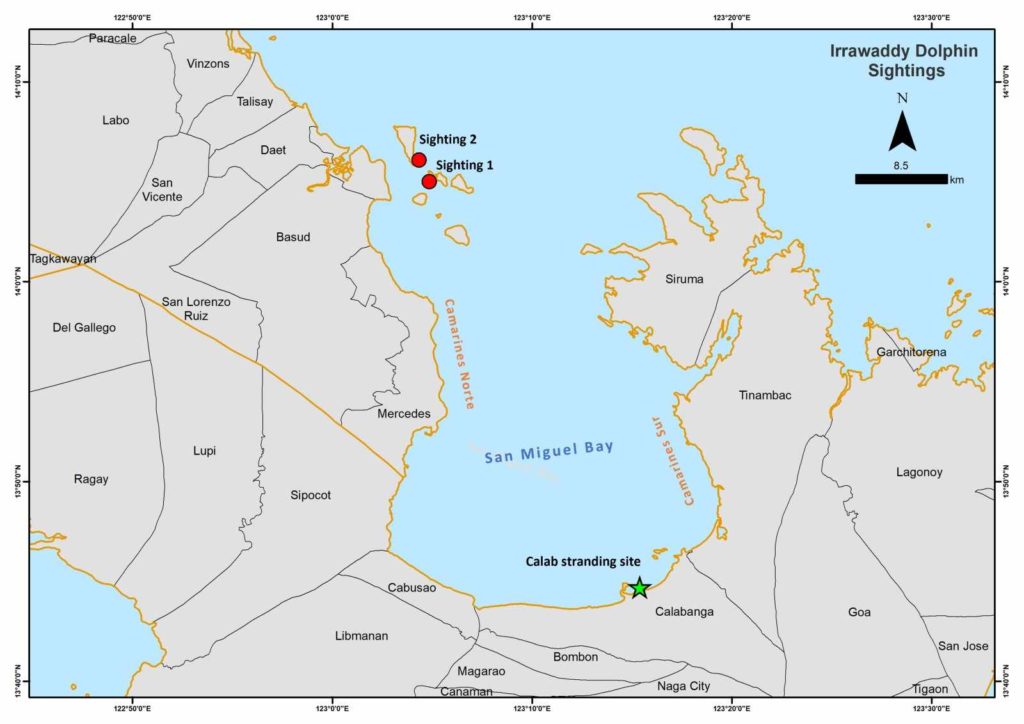Irrawaddy dolphins disappearing population of San Miguel Bay in Bicol are already at risk of disappearing from the region, confirmed by a recent survey mission by scientists.
Irrawaddy dolphins (Orcaella brevirostris) are characterized by gray or dark-blue backs and pale bellies, with a high tolerance to various levels of salinity that enables them to live in areas where salty seawater and freshwater meet – such as in the mouths of rivers and bays. They are among the world’s most endangered dolphin species, indicated as critically endangered on the Red List of the International Union for Conservation of Nature (IUCN). They are also considered critically endangered by the Philippine Department of Environment and Natural Resources (DENR).
A mission to find live Irrawaddy dolphins in the area of San Miguel Bay in Bicol led scientists from the University of the Philippines – Diliman College of Science Institute of Environmental Science and Meteorology (UPD-CS IESM) to validate the existence in the area of this critically-endangered species during a recent dolphin survey conducted from July 6 to 9, 2023.
Efforts to locate Irrawaddy dolphins
The team, led by IESM Professor and Marine Mammal Research and Conservation Laboratory (MMRCL) Head Dr. Lemnuel Aragones, sighted two Irrawaddy dolphins—one near Apuao Island and another near Canimog Island, both in the waters of Mercedes, Camarines Norte.
“These dolphins prefer brackish waters, making the San Miguel Bay area an ideal place for the Irrawaddy dolphins to thrive, with its shallow depth, a wide range of salinities, and presence of nearby offshore islands,” Dr. Aragones explained.

The IESM researchers and the Bureau of Fisheries and Aquatic Resources Regional Office 5 (BFAR5) were motivated to organize the dolphin survey after conducting key informant interviews in October 2022 about a stranded Irrawaddy dolphin reported as a bycatch in August of the same year.
The team covered a total area of about 680 square kilometers. In terms of travel distance, they covered a total of 335 kilometers in 23 hours, spread over four days, with transects traversing the shorelines of towns in Camarines Norte and Camarines Sur.
Seeking refuge in San Miguel Bay
According to Dr. Aragones, not only do these rare sightings of Irrawaddy dolphins confirm their existence in San Miguel Bay, they also indicate that only a few of these dolphins are left. “It is most likely that the Irrawaddy dolphins are using the offshore islands in the San Miguel Bay as a refuge area, and that there is now probably much less food for them there since it is one of the most over-exploited fishing grounds in the country,” Dr. Aragones explained.
Dr. Aragones also urged the creation of an action plan with BFAR5 on the protection and conservation of these critically-endangered dolphins. “I already talked with BFAR5 Regional Director Ariel Pioquinto about enhancing San Miguel Bay again to ensure the Irrawaddy dolphins’ habitat,” he said. “We hope to harmonize local ordinances with existing national laws regarding protected species.”
The dolphin survey team was composed of spotters from IESM; the BFAR5 – Fisheries Protection and Law Enforcement Group (BFAR5-FPLEG); the BFAR – Fisheries Resources Management Section (BFAR5-FRMS), and the Ateneo de Naga University Institute for Environmental Conservation and Research (INECAR).
Other populations of Irrawaddy dolphins in the Philippines can be found in Malampaya Sound in Palawan and the Iloilo-Guimaras-Negros Occidental area.